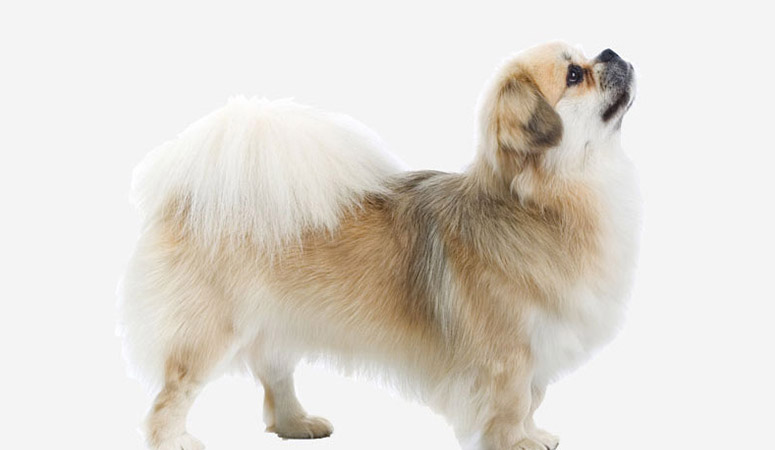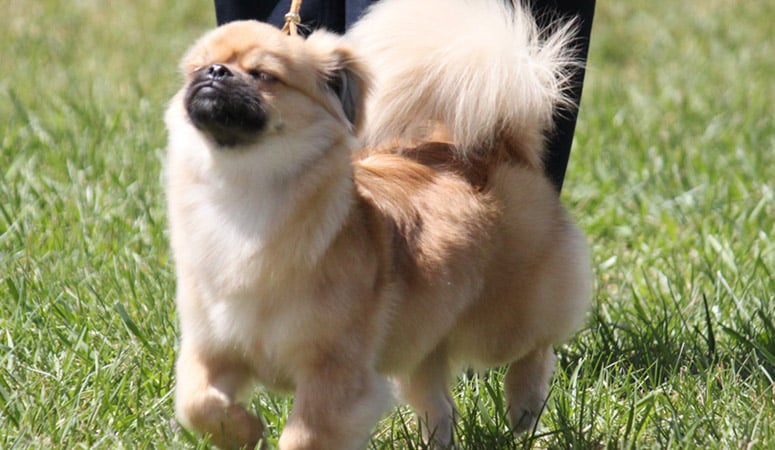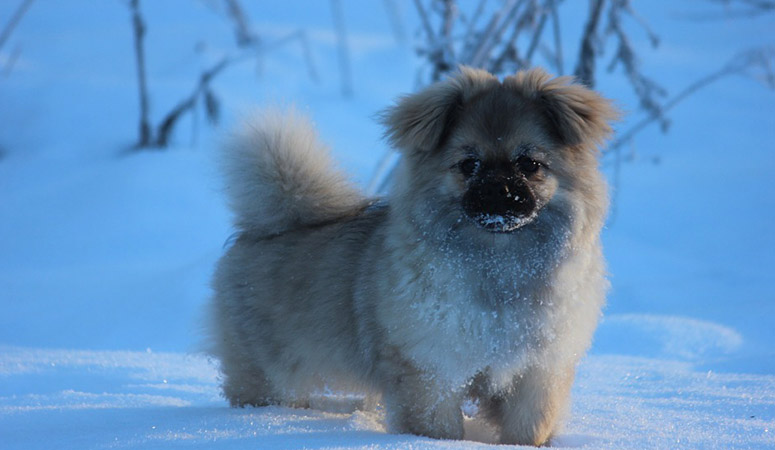Tibetan Spaniel

With muscular midsize, the Tibetan Spaniels are bred to do sentinel work on the walls of Tibetan monasteries. Also they love to hunt and swim with their dense and waterproof coat. This breed, as a hunter, combines the working traits of spaniels and retrievers. Although happy, eager, and charming with their adored human, they are a little stubborn when facing the strangers.
| Other Names | Simkhyi |
| Color | Black, Black & Tan, Cream, Gold, Red, Sable, Silver Sable, White |
| Height | Males: 9-11 inches. Females: 9-11 inches. |
| Weight | Males: 9-15 pounds. Females: 9-15 pounds. |
| Life Span | 12-15 years |
| Personality | Playful, Bright, Self-Confident |
| Exercise | Regular Exercise |
| Origin |
| Popularity | #117 |
| Groom Needs | Weekly Brushing |
| Kids Friendly | Yes |
| Dog Friendly | Yes with supervision |
| Watch Dog | |
| Family Dog | |
| Litter Size | 3 to 6 puppies |
Tibetan Spaniel Pictures
Tibetan Spaniel Video
Introduction
The Tibetan Spaniels loves to perch on the back of the sofa and survey his surroundings. He doesn’t bark much without reason but will alert you to anything suspicious going on around him. They adore their members of the family, and lots of people liken them to cats, being calm, dignified, and loving to be perched upon a high place. They are just too cuddly and affectionate for words, and love being snuggled up on the couch with their owners. Because they are small, they are best with kids over 6 years who have been taught to be careful and show respect around them. They are only about 10 inches at the shoulders and weigh only around 15 pounds. Their coats are silky and come in any colors. Their coats just require weekly brushing. The Tibetan Spaniel is sensitive and will shut down if you attempt to use harsh methods or a heavy hand on him. Provide plenty of socialization opportunities starting in early puppyhood. Introduce him to many different people, sounds, places, and other animals, etc. They might be little dogs, but don’t carry your Tibbie pup around like it’s a human baby. Let the puppy walk and explore things with his four little paws on the ground to help strengthen and gain confidence. He needs daily strolls around the neighborhood or some fun frolicking in the safety of an enclosed yard – he definitely thrives on lots of quality time with his human family – they will never do well when left alone for hours on end.
Living with Tibetan Spaniel
Tibetan Spaniels need light shedding, with a heavier shed once or sometimes twice a year.
Start grooming your Tibetan Spaniel when he’s a puppy to get him used to it. Make grooming a positive experience filled with praise and rewards, and you’ll lay the groundwork for easy veterinary exams and other handling when he’s an adult.
They typically require a bath every six to eight weeks.
Brushing two or three times a week will keep loose hair under control and keep the coat free from tangles or mats.
Nails should be trimmed once per month if the dog does not wear the toenails down naturally. Short nails keep the feet in good condition, don’t get caught in the carpet and tear, and don’t scratch your legs when your Tibetan Spaniel enthusiastically jumps up to greet you.
Handle his paws frequently — dogs are touchy about their feet.
Check the Tibetan Spaniel’s ears on a weekly basis for signs of infection, irritation, or wax build up. You should clean their ears regularly with a veterinarian-approved cleanser and cotton ball.
Brush the teeth at least once per week to prevent tartar buildup and fight gum disease. Of course daily brushing will be better.
The Tibetan Spaniels make wonderful companions for seniors as they don’t need a lot of daily exercise. A healthy Tibetan Spaniel requires between 30 minutes and one hour of moderate exercise each day.
A few walks and a play session in the yard or living room will keep them fit. A fenced yard is a must.
They are a great breed for owners who would like a dog to accompany them on long walks or jogs, as they are able to keep up with their human partner. So keep your Tibbie attended, as this dog needs to be with you and will be happiest when playing with you.
Tibetan Spaniels were bred to live indoors. They relish their two jobs of keeping watch over their home and being joyful companions.
Tibbies like to climb to high perches, so don’t be surprised if they relax on the backs of chairs and sofas.
Tibbies enjoy heading outside for adventures in the back yard or farther afield. With their warm double coats, they are well suited to outdoor winter fun, as well.
Tibetan Spaniels aren’t drawn to the water like some breeds, though some of them may enjoy wading when it’s hot outside. Never force swimming on any dog and always watch your dog closely when he is in or near water.
Generally, this breed requires about 0.75 to 1 cup of good quality dry dog food each day, given in two feedings. Tibetan Spaniels can thrive on a number of different diets, from dry kibble to raw diets.
But the amount will vary with your Tibby’s size, metabolism, activity level and age. Talk to your veterinarian about the optimal diet and quantity of food for your Tibetan Spaniel.
The quality of dog food you buy also makes a difference — the better the dog food, the further it will go toward nourishing your dog and the less of it you’ll need to shake into your dog’s bowl.
Some dogs are prone to getting overweight, so watch your dog’s calorie consumption and weight level. Treats can be an important aid in training, but giving too many can cause obesity.
Clean, fresh water should be available at all times.
Learn about which human foods are safe for dogs, and which are not. Check with your vet if you have any concerns about your dog’s weight or diet.
Tibetan Spaniels are generally healthy, but just like all breeds, they can get certain conditions, such as progressive retinal atrophy (PRA), portosystemic shunts (PSS) or “liver shunts”, hernias (often corrected during spay/neuter surgery), patellar luxation, hip dysplasia and cherry eye, etc. Some health problems don’t appear until a dog reaches full maturity.
Not all Tibetan Spaniels will get any or all of these diseases, but it’s important to be aware of them if you’re considering this breed.
There are several and health tests considerations specific to the breed, such as patella evaluation and ophthalmologist evaluation.
Responsible breeders screen their stock regularly. Before going to their new homes, puppies should be checked for liver shunt, in which the blood flow around and/or through the liver is affected.
Total Annual Cost: $2674
Cost is estimated for the first year and may vary depending on many factors, such as dog food, health care, leash, collar, licensing, possible fencing, crates, training and obedience classes, dog-walking, grooming, treats, toys, flea, tick, and heart-worm meds, microchips, etc.
Intelligent but stubborn, Tibbies can be challenging to train. Dog sports, agility training, and advanced obedience training are good ways to keep Tibetan Spaniels fit and mentally challenged.
Socialization in puppyhood is a must. They have a very independent mind, however, and will decide if and when they will do what is asked of them, so an early start to training is needed, and it should be a fun and enjoyable time.
Consistency and plenty of positive reinforcement, such as praise and treats, will yield the best results. And keep training sessions short and interesting to hold your dog’s attention.
Tibetan Spaniels are known to be vocal, alerting you to a stranger’s presence. With patience and consistency, it is possible to train them to stop barking once they’ve alerted you to the possible threat.
Tibetan Spaniels are generally easy to housetrain, and crate training is strongly recommended, which will make housetraining easier and keep your Tibetan Spaniel from chewing things while you’re not there to there is no supervision. However, don’t keep your Tibetan Spaniel locked up in it for long periods. The best place for a Tibetan Spaniel is with you.
Tibbies are housedogs. They thrive on spending time with their people, and they’re not suited to living outdoors or in a kennel. Because they may run off to explore, yards must be fenced and they should be walked on leash.
History
The lovely little Tibetan Spaniels were used by Buddhist monks in the Himalayan Mountains of Tibet as watchdogs. They would have to patrol the tops of monastery walls and bark when intruders were around. Then the monks and big Tibetan Mastiffs dogs would come out and investigate.
The Tibetan Spaniel is an ancient breed that has existed in Tibet for more than 2,000 years and their Buddhist monk owners loved and treasured their dogs, deeming them way too precious to sell. That meant they could only be gifted.
The first Tibetan Spaniels arrived in England in 1898, but they weren’t bred in that country until much later. They arrived in the United States in the 1960s, and the Tibetan Spaniel Club of America was formed in 1971.
The breed received full recognition from the American Kennel Club in 1984, under the Non-Sporting Group. Although it has “spaniel” in its name, the breed name is actually a misnomer because the Tibetan Spaniel is not actually a spaniel. Spaniels are hunting dogs, and the Tibetan Spaniel is in the non-sporting group.
Helpful Information
Breed Club: TIBETAN SPANIEL CLUB OF AMERICA, INC.
Breed Club Link: https://www.tsca.ws/
Breed Club Rescue: The Tibetan Spaniel Club of America Rescue & Health Trust
Breed Club Rescue Link: https://tstrust.org/rescue/




